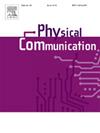基于高斯信道误差估计的协同认知车辆网络可靠可控安全传输策略
IF 2.2
4区 计算机科学
Q3 ENGINEERING, ELECTRICAL & ELECTRONIC
引用次数: 0
摘要
认知无线电(CR)和协作通信(CC)是两种有效的技术,旨在缓解频谱短缺和提高车载网络的吞吐量,但它们的集成带来了多方面的安全问题。本研究探讨了底层协同认知车辆网络(CCVNs)中可靠性和物理层安全性(PLS)之间的权衡。在CCVNs中,辅助车辆通过解码转发(DF)中继与目标车辆通信,并且在此过程中存在具有不完美信道状态信息(ipCSI)的窃听器。考虑到高斯信道误差估计,我们采用了更现实的系统模型。基于该模型,设计了一种可靠可控的安全传输策略,并推导出传输延迟、安全性、可靠性和吞吐量等关键性能指标的封闭表达式。这些表达式是利用计算的瞬时等效信噪比(SNR)的累积分布函数(CDF)得到的。在满足可靠性约束的前提下,对关键参数进行优化,使保密吞吐量最大化。数值计算和仿真实验结果表明,与传统方法相比,该策略在可靠性方面有显著提高。本文章由计算机程序翻译,如有差异,请以英文原文为准。
A reliability-controllable secure transmission strategy for cooperative cognitive vehicular networks under Gaussian channel error estimation
Cognitive radio (CR) and cooperative communication (CC) represent two potent technologies designed to alleviate spectrum scarcity and improve the throughput of vehicular networks, while their integration has introduced multifaceted security concerns. This work explores the tradeoff between reliability and physical layer security (PLS) within the underlay cooperative cognitive vehicular networks (CCVNs). In CCVNs, a secondary vehicle communicates with the destination vehicle via a decode-and-forward (DF) relay, and an eavesdropper with imperfect channel state information (ipCSI) is present in the process. We adopt a more realistic system model considering Gaussian channel error estimation. Based on this model, we design a reliability-controllable secure transmission strategy and derive closed-form expressions for key performance indicators, including transmission delay, security, reliability, and throughput. These expressions are obtained by leveraging the computed cumulative distribution function (CDF) of the instantaneous equivalent signal-to-noise ratio (SNR). Furthermore, we optimize key parameters to maximize the secrecy throughput while meeting reliability constraints. Results from numerical calculations and simulation experiments highlight the significant improvement in reliability offered by the proposed strategy over conventional methods.
求助全文
通过发布文献求助,成功后即可免费获取论文全文。
去求助
来源期刊

Physical Communication
ENGINEERING, ELECTRICAL & ELECTRONICTELECO-TELECOMMUNICATIONS
CiteScore
5.00
自引率
9.10%
发文量
212
审稿时长
55 days
期刊介绍:
PHYCOM: Physical Communication is an international and archival journal providing complete coverage of all topics of interest to those involved in all aspects of physical layer communications. Theoretical research contributions presenting new techniques, concepts or analyses, applied contributions reporting on experiences and experiments, and tutorials are published.
Topics of interest include but are not limited to:
Physical layer issues of Wireless Local Area Networks, WiMAX, Wireless Mesh Networks, Sensor and Ad Hoc Networks, PCS Systems; Radio access protocols and algorithms for the physical layer; Spread Spectrum Communications; Channel Modeling; Detection and Estimation; Modulation and Coding; Multiplexing and Carrier Techniques; Broadband Wireless Communications; Wireless Personal Communications; Multi-user Detection; Signal Separation and Interference rejection: Multimedia Communications over Wireless; DSP Applications to Wireless Systems; Experimental and Prototype Results; Multiple Access Techniques; Space-time Processing; Synchronization Techniques; Error Control Techniques; Cryptography; Software Radios; Tracking; Resource Allocation and Inference Management; Multi-rate and Multi-carrier Communications; Cross layer Design and Optimization; Propagation and Channel Characterization; OFDM Systems; MIMO Systems; Ultra-Wideband Communications; Cognitive Radio System Architectures; Platforms and Hardware Implementations for the Support of Cognitive, Radio Systems; Cognitive Radio Resource Management and Dynamic Spectrum Sharing.
 求助内容:
求助内容: 应助结果提醒方式:
应助结果提醒方式:


